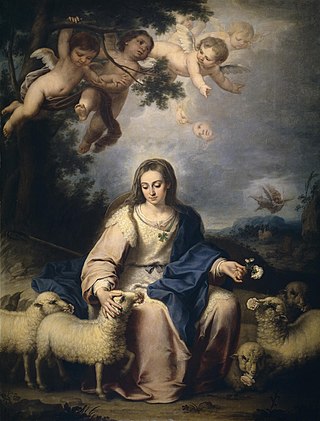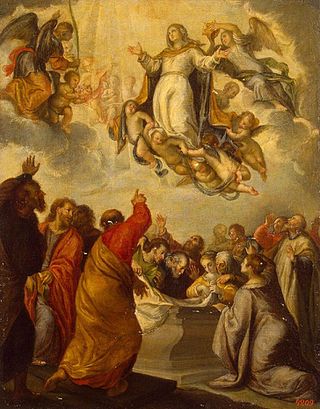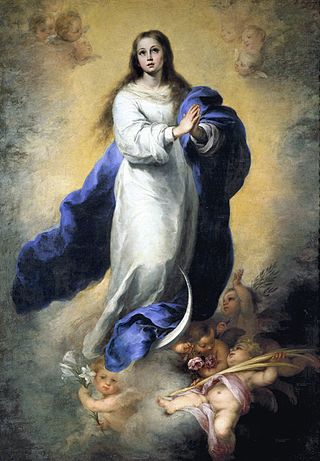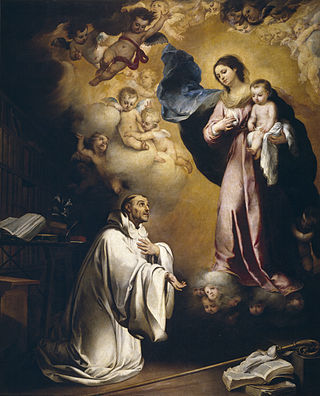
Bartolomé Esteban Murillo was a Spanish Baroque painter. Although he is best known for his religious works, Murillo also produced a considerable number of paintings of contemporary women and children. These lively realistic portraits of flower girls, street urchins, and beggars constitute an extensive and appealing record of the everyday life of his times. He also painted two self-portraits, one in the Frick Collection portraying him in his 30s, and one in London's National Gallery portraying him about 20 years later. In 2017–18, the two museums held an exhibition of them.

The Prado Museum, officially known as Museo Nacional del Prado, is the main Spanish national art museum, located in central Madrid. It is widely considered to house one of the world's finest collections of European art, dating from the 12th century to the early 20th century, based on the former Spanish royal collection, and the single best collection of Spanish art. Founded as a museum of paintings and sculpture in 1819, it also contains important collections of other types of works. The Prado Museum is one of the most visited sites in the world and is considered one of the greatest art museums in the world. The numerous works by Francisco Goya, the single most extensively represented artist, as well as by Hieronymus Bosch, El Greco, Peter Paul Rubens, Titian, and Diego Velázquez, are some of the highlights of the collection. Velázquez and his keen eye and sensibility were also responsible for bringing much of the museum's fine collection of Italian masters to Spain, now one of the largest outside of Italy.

Francisco de Zurbarán was a Spanish painter. He is known primarily for his religious paintings depicting monks, nuns, and martyrs, and for his still-lifes. Zurbarán gained the nickname "Spanish Caravaggio", owing to the forceful use of chiaroscuro in which he excelled.

Alonso Cano Almansa or Alonzo Cano was a Spanish painter, architect, and sculptor born in Granada.

The Assumption of the Virgin is an oil on canvas painting by Greek artist Doménikos Theotokópoulos, known as El Greco, in 1577–1579. The painting was a central element of the altarpiece of the church of Santo Domingo el Antiguo in Toledo, Spain. It was the first of nine paintings that El Greco was commissioned to paint for this church. The Assumption of the Virgin was El Greco's first work in Toledo and started his 37-year career there. Under the influence of Michelangelo, El Greco created a painting that in essence was Italian, with a naturalistic style, monumental figures, and a Roman school palette. The composition of El Greco's depiction of the Assumption of the Virgin resembles Titian's Assumption in the Basilica dei Frari in Venice with Virgin Mary and angels above and the apostles below. On the painting Virgin Mary floats upward which symbolizes her purity, while apostles gathered around her empty tomb express amazement and concern.

Francesco Trevisani was an Italian painter, active in the period called either early Rococo or late Baroque (barochetto).

Pedro Nuñez de Villavicencio (1635–1700) was a Spanish Baroque painter. He was born in Seville in 1635. He was trained by Murillo. He was named a knight of the order of San Juan. As a knight of the order, he performed duties in Malta, where he met Mattia Preti. When he returned to Spain, along with Murillo, he helped establish the Academia de Seville. When Murillo died, he traveled to Madrid. He died in Seville in 1700.
Félix Castello or Castelo was a Spanish painter of the Baroque period.

Bernardo Germán de Llórente was a Spanish painter of the late-Baroque period. He was active in Seville where he was one of the followers of Murillo and made a name with his devotional paintings of the Virgin Mary. He also painted portraits and still lifes with trompe-l'œil effects.

Francisco Camilo was a Spanish painter, the son of an Italian immigrant who had settled in Madrid. When his father died, his mother remarried, and Camilo became the stepson of the painter Pedro de las Cuevas.

Mateo Cerezo, sometimes referred to as The Younger was a Spanish Baroque painter; known primarily for religious works and still-lifes.

The Wine of Saint Martin's Day is the largest painting by Pieter Bruegel the Elder. It is currently held in the Museo del Prado, Madrid, where it was identified as a Bruegel original in 2010. Like much of Bruegel's work it depicts peasant life, in this case a festival known as St. Martin's Day, which involves drinking the first wine of the season.

José Jiménez Aranda was a Spanish painter and brother of the painters Luis Jiménez Aranda and Manuel Jiménez Aranda.

The Mural Paintings from the Herrera Chapel is a group of mural paintings by Annibale Carracci and collaborators, of around 1602, now divided between the National Art Museum of Catalonia in Barcelona, and the Museo del Prado in Madrid.

José Villegas Cordero was a Spanish painter of historical, genre and costumbrista scenes.
Andres Rossi was a Spanish artist. He worked as a painter, draughtsman, print maker, sculptor and writer in Madrid and Seville.

The Immaculate Conception of El Escorial is a circa 1660–1665 oil religious painting by the Spanish Baroque artist Bartolomé Esteban Murillo, now in the Museo del Prado in Madrid. Murillo's many artistic depictions of the immaculate conception of the Virgin Mary were enormously influential on later art. This painting is regarded as one of his best. It was earlier identified as the Immaculate Conception of the Granja due to a mistaken understanding of its history.

The Immaculate Conception of Los Venerables or The Immaculate Conception of Soult is an oil painting by the Spanish artist Bartolomé Esteban Murillo. It was painted c. 1678 and measures 274 cm × 190 cm. Looted by Marshal Jean-de-Dieu Soult in 1813 and taken to France, it was bought by the Louvre in 1852. It has been held by the Museo del Prado, Madrid, since 1941.

Our Lady of the Rosary is an oil on canvas painting of Our Lady of the Rosary by Bartolomé Esteban Murillo, created c. 1650-1655. It was previously in the El Escorial Monastery and Palacio Real de Madrid and now is held in the Museo del Prado, in Madrid.

The Apparition of the Virgin to Saint Bernard is an oil on canvas painting by Spanish artist Bartolomé Esteban Murillo, created c. 1655, now held in the Museo del Prado in Madrid. The picture shows a miraculous Marian apparition to Catholic theologian Bernard of Clairvaux during his study time, what causes him to fall on his knees. His books and desk can be seen in the background.


















